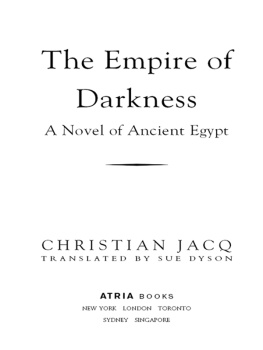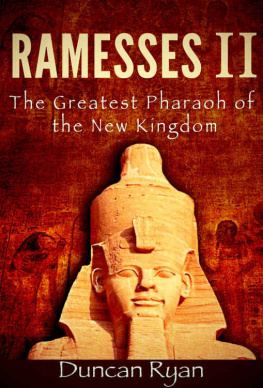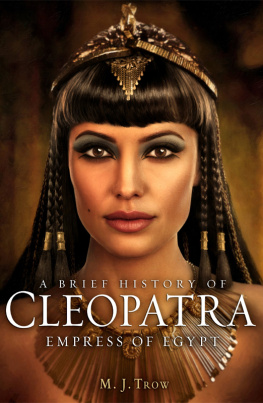PENGUIN BOOKS
HATCHEPSUT
Joyce Ann Tyldesley was born in Bolton, Lancashire. She gained a first-class honours degree in archaeology from Liverpool University in 1981 and a doctorate from Oxford University in 1986. She is now Honorary Research Fellow at the School of Archaeology, Classics and Oriental Studies at Liverpool University, and a freelance writer and lecturer on Egyptian archaeology. Her books, which are published by Penguin, include Daughters of Isis: Women of Ancient Eygpt, Hatchepsut: The Female Pharaoh, Nefertiti and Ramesses: Egypt's Greatest Pharaoh.
By the same author
DAUGHTERS OF ISIS
HATCHEPSUT
THE FEMALE PHARAOH
JOYCE TYLDESLEY

PENGUIN BOOKS
PENGUIN BOOKS
Published by the Penguin Group
Penguin Books Ltd, 80 Strand, London WC2R 0RL, England
Penguin Putnam Inc., 375 Hudson Street, New York, New York 10014, USA
Penguin Books Australia Ltd, 250 Camberwell Road, Camberwell, Victoria 3124, Australia
Penguin Books Canada Ltd, 10 Alcorn Avenue, Toronto, Ontario, Canada M4V 3B2
Penguin Books India (P) Ltd, 11 Community Centre, Panchsheel Park, New Delhi 110 017, India
Penguin Books (NZ) Ltd, Cnr Rosedale and Airborne Roads, Albany, Auckland, New Zealand
Penguin Books (South Africa) (Pty) Ltd, 24 Sturdee Avenue, Rosebank 2196, South Africa
Penguin Books Ltd, Registered Offices: 80 Strand, London WC2R 0RL, England
www.penguin.com
First published by Viking 1996
Published in Penguin Books 1998
Copyright J. A. Tyldesley, 1996
All rights reserved
The moral right of the author has been asserted
Except in the United States of America, this book is sold subject to the condition that it shall not, by way of trade or otherwise, be lent, re-sold, hired out, or otherwise circulated without the publisher's prior consent in any form of binding or cover other than that in which it is published and without a similar condition including this condition being imposed on the subsequent purchaser
ISBN: 978-0-14-192934-7
For William Jack Snape
Contents
Plates
Figures
Maps and Chronologies
Acknowledgements
Many people have helped with the preparation of this book, and I would like to express my gratitude to all concerned. First and foremost I must thank my husband, Steven Snape, for his unflagging support, encouragement and cooking. Thanks are also due to Eleo Gordon and Sheila Watson who gave practical advice whenever needed, to Bill Tyldesley who provided translations from German sources, and to the members of the Liverpool University S.E.S. photography department, Ian Qualtrough and Suzanne Yee, who produced photographic prints at lightning speed. Plates 5 and 10 are published by kind permission of the Metropolitan Museum of Art, New York.
Introduction

My command stands firm like the mountains, and the sun's disk shines and spreads rays over the titulary of my august person, and my falcon rises high above the kingly banner unto all eternity.
Queen or, as she would prefer to be remembered, King Hatchepsut ruled 18th Dynasty Egypt for over twenty years. Her story is that of a remarkable woman. Born the eldest daughter of King Tuthmosis I, married to her half-brother Tuthmosis II, and guardian of her young stepsonnephew Tuthmosis III, Hatchepsut somehow managed to defy tradition and establish herself on the divine throne of the pharaohs. From this time onwards Hatchepsut became the female embodiment of a male role, uniquely depicted both as a conventional woman and as a man, dressed in male clothing, carrying male accessories and even sporting the traditional pharaoh's false beard. Her reign, a carefully balanced period of internal peace, foreign exploration and monumental building, was in all respects except one obvious one a conventional New Kingdom regime; Egypt prospered under her rule. However, after Hatchepsut's death, a serious attempt was made to delete her name and image from the history of Egypt. Hatchepsut's monuments were either destroyed or usurped, her portraits were vandalized and her rule was omitted from the official king lists until only the historian Manetho preserved the memory of a female monarch named Amense or Amensis as the fifth sovereign of the 18th Dynasty.
Had Hatchepsut been born a man, her lengthy rule would almost certainly be remembered for its achievements: its stable government, successful trade missions and the impressive architectural advances which include the construction of the Deir el-Bahri temple on the west bank of the Nile at Luxor, a building which is still widely regarded as one of the most beautiful in the world. Instead, Hatchepsut's gender has become her most important characteristic and almost all references to her reign have concentrated not on her policies but on the personal relationships and power struggles which many historians have felt able to detect within the claustrophobic early 18th Dynasty Theban royal family. Two interlinked questions arise again and again, dominating all accounts of Hatchepsut's life: What made a hitherto conventional queen decide to become a king? And how, in a highly conservative and male-dominated society, was she able to achieve her goal with such apparent ease?
It has generally been allowed that the answer to these riddles must be sought in the character of the woman herself. However, this is where all agreement ends as the identical and rather limited set of facts has suggested radically diverse images of the same woman to different observers, to the extent that a casual reader browsing along a shelf of egyptology books might be forgiven for assuming that Hatchepsut suffered from a seriously split personality. Egyptologists, normally the most dry and cautious of observers, have been only too happy to allow their own feelings to intervene in their telling of Hatchepsut's tale and, more particularly, in their interpretation of the motives underlying her deeds. These feelings have tended to coincide with the beliefs common to a generation, so we find egyptologists at the turn of the century, unaware of the complexities of the Tuthmoside succession and accustomed to the idea of successful female rule personified by Queen Victoria, happy to accept Hatchepsut's own propaganda. To these champions Hatchepsut was a valid monarch, an experienced and well-meaning woman who ruled amicably alongside her young stepson, steering her country through twenty peaceful, prosperous years.
Though unmentioned in the Egyptian king lists, [she] as much deserves to be commemorated among the great monarchs of Egypt as any king or queen who ever sat on its throne during the 18th Dynasty.
As a woman who did not fall below the standard of the rest of the 18th Dynasty [having given] early evidence of her capacity to reign, In summary:
though she has never been considered as a legitimate sovereign, and though she has left us no account of great conquests, her government must have been at once strong and enlightened, for when her nephew Tuthmosis III succeeded her, the country was sufficiently powerful and rich to allow him to venture not only on the building of great edifices, but on a succession of wars of conquests which gave him, among all the kings of Egypt, a pre-eminent claim to the title of the Great.
By the 1960s, knowledge of early 18th Dynasty history had increased, the climate of opinion had changed, and Hatchepsut had been transformed into the archetypal wicked stepmother familiar from the popular films
Next page






